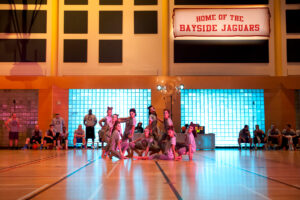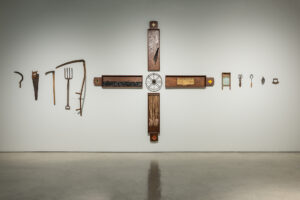Over the past decade, Windsor artist Natalie Mayville has been working on a series of remarkable paintings. Using a limited palette of colours Mayville layers paint and other materials in abstract compositions, which can be up to twelve feet long. The process she employs is laborious and time consuming; it often takes several months to complete one work. The finished paintings are interspersed with bits of collaged images and texts, often rendered inaccessible to the viewer and revealed only where the surface has been distressed or ruptured. Embedded in the painted surface, these fragments hover on the edge of the visible.
The paintings, which are on wood panels, are composed of joint compound, paper, tape, rope, fabric, bark and other found materials. Mayville uses latex and oil paint and draws into them extensively with various tools. She uses these materials to create a complex surface layered with marks, painted passages, and bits of text.
In describing her work, she refers to the ancient idea of palimpsest: a writing tablet that has been inscribed more than once, on which earlier texts remain visible. She is interested in these fragments rather than cohesive narratives, and the way in which they evoke the past. The paintings record time, events and ideas, yet in their masked construction reflect the disconnected and indistinct quality of memory.
Like Catalan painter Antoni Tapies, Mayville sees herself as an ‘atist mason’ reworking architectural surfaces. In some respects, she is like an archaeologist unearthing the past through fragmentary evidence. She is interested in what she calls the ‘ poetry of decay’, exploring Windsor and Detroit to collect materials for her collages from abandoned buildings. According to her,”collage reflects modern life – societies reveal themselves in these papers left on the streets.”






